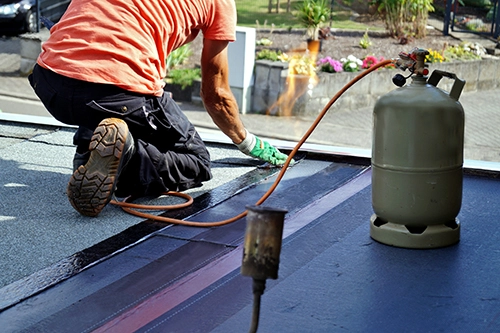- About Us
- Services
- Blog
- Contact
Need a quote?
Here at Environ Roofing, we handle several emergency roofing jobs, especially throughout the winter when the weather is at its harshest.
As such we’ve had plenty of chances to observe the most common causes of roofing damage as well as the various factors that can make roof damage more severe.
Today we’ll be talking about some of the main culprits behind roofing emergencies and what you can do to stop them in their tracks.




Before we go on, it’s important to say that no roof lasts forever. In centuries gone by, thatched roofs needed to be replaced once every decade or so. Modern roofs generally last a bit longer, especially if they’re well maintained, but sooner or later those materials will start to degrade.
As a rule, if your roof hasn’t been maintained or repaired in more than twenty years then you should probably have it surveyed just in case. Catching signs of ageing soon enough can help you to preserve your roof for a lot longer than might otherwise have been possible.
It should come as no surprise that November through to February is the season for emergency roofing repairs.
Although roofs are generally built to last against the elements, high winds can carry rocks and debris, often causing small cracks and chips. On their own, these aren’t too much of a concern - though they might start to make your roof look shabby - but if you start losing whole tiles then that’s a big no-no.
A lost or damaged roof tile can leak water, causing far more damage in the long run.
While we’re talking about the weather, let’s not forget the ever-increasing effects of climate change. Extreme weather events are becoming more and more common year on year. Rain, wind, cold snaps, and heat waves all compound to give your roof quite the beating as the materials expand and contract over the year.
The result of all this is that damage is less predictable now than ever before so be sure to keep an extra close eye on your roof at the extremes of the seasons.
Last but not least, many people don’t realise this but faulty and blocked gutters can also cause roofing damage if you’re not careful. Allowing your gutters to get blocked means that runoff has nowhere to go, placing more strain on your roofing insulation. In the short term, this isn’t too much of a concern but it can seriously reduce the lifespan of your roof in the long run.
It depends on the construction, but the minimum weight a flat roof must be capable of bearing is 300lbs. This refers to a concentrated weight where a load is positioned on just one area of the roof. So, for example, a commercial flat roof can approximately support a 300lb HVAC unit in a 2.5×2.5ft single space.
If you opt for a flat roof anywhere on your property, remember that it comes with a need for proper maintenance. Low-slope roofing London-wide should be checked every six months or so, or after spells of bad weather, to spot any signs of damage. No matter how small, these should be addressed before they escalate. Remove any debris (leaves, twigs and so on) regularly to avoid these blocking the gutters and allowing water to pool and stand on the roof.
If there are trees in the close vicinity, keep them cut back to reduce the amount of foliage that falls on your flat roof. And check internally for signs of moisture, dampness or water damage on a regular basis. Spotting problems early means resolving them will be cheaper in the long run.

Building a flat roof can be done in three ways. The simplest and most cost-effective choice for levelled roofing London-wide is to construct a warm roof where a roofing membrane is placed over the insulation that keeps the timber structure warm. Another option is to create a cold roof where insulation is positioned between the rafters under the ply roof covering. This is commonly applied to flat-roofed extensions.
The third method is the hybrid roof that contains diverse elements. Their designs require a gap of ventilation above a warm roof to prevent excess moisture within the roof structure.
If you’re looking for flat roofing local contractors, don’t just select the first firm you come across. Find a roofing company that’s been in business for a while and can demonstrate a good track record in installing, repairing, and replacing flat roofs specifically. Ask for recommendations from your own network or from a local trade association. If you need refurbishment work done to 50% or more of your roof, you’ll need a roofing contractor who can self-certify their work under the Competent Person Scheme. Otherwise, the Building Control department at your local authority will need to approve the job before it begins.
Ask whether they are covered by liability insurance and how long they’ll guarantee the work they will carry out. And never just opt for the cheapest quote unless you’re quite sure they’re the best company for the job. You can’t afford to compromise on your roof as the structural integrity of your property depends on it.
Ensuring your flat roof will comply with building regulations before installation can save property owners time, money and stress. First, the roof must have a slope of around 1:80, with water draining away to one or two roof edges. Waterproofing must be extended up to the adjacent walls with at least 150 mm from the surface of the roof.
Contractors must install ventilation in cold roofs. For warm roofs, the deck must be bonded with a VCL. The roof should have the capacity to withstand strong winds and be sturdy enough to take an individual’s weight. Finally, check whether planning permission is needed. Typically, this is only required if you live in a conservation area or a listed building, or are making significant changes to an existing roof.
If you’re looking for top roofing solutions at competitive rates, check out our range of roofing services at Environ Roofing Company London. To get started, call one of our representatives today!

